Abstract
The main objective of this research is to analyse the perception of visitors in protected natural areas struggling with mass tourism. An exhaustive analysis is carried out of both the tourist activity and the profile of the tourists in the Garganta de los Infiernos Natural Reserve (Extremadura, Spain). It studies variables such as the number of visitors, their personal profile, their perception of the protected area after the visit, etc. The method used was non-experimental, descriptive, qualitative and analytical, and it allowed for a better understanding of the profile of the visitors: sex, age, origin, professional profile, etc. The results show the visitors’ conviction about the need to properly manage areas of public use, mainly due to the notable and partly uncontrolled growth of tourism activity during certain periods of the year. On the other hand, the relevance of the actions of the Governing Board of the Natural Reserve is highlighted, as it guarantees public participation and channels the opinions of the main partners involved in the management of the protected area, to ensure a responsible management of tourism activity and improve its quality.
1. Introduction
The protected areas are a key component of any global conservation strategy. “Tourism provides a crucial and unique way of fostering visitors’ connection with protected area values, making them a potentially positive force for conservation” [1] (p. 2). Equally, the tourism in protected areas generates many impacts on the environment, the economy, local communities and the visitors themselves.
Tourism in general is growing annually due essentially to sociodemographic changes and new ways of life in today’s society [2]. Protected natural areas are in demand by more than 10 million visitors annually [3].
In recent years, the increasing mobility of the population, the rise in purchasing power and the greater availability of leisure time have brought about an increasing flux of visitors in protected natural areas. This situation demands better planning and the suitable management of spaces for public enjoyment [4,5].
This large amount of visitors obliges the managers of protected natural areas to preserve facilities and keep the offer of services and quality activities to visitors. Moreover, they must guarantee management frameworks adapted to preservation strategies [6,7] and to the social variables related to the management of protected natural areas [8].
The concept of governance in protected natural areas is not new, since “as long as protected areas have existed, decisions have always been made about them” [9] (p. 47). These activities are developed in the areas of public use.
For that reason, “The World Tourism Organization” [10] is the United Nations’ specialised agency in charge of boosting sustainable and universally accessible tourism. UNWTO (United Nations World Tourism Organization) promotes tourism as one of the most favourable ways to achieve the United Nations Sustainable Development Goals (SDGs).
In general, visitors to protected natural areas wish to get involved in different activities (either individually or in groups): leisure, didactic, touristic, scientific, culture-related, aesthetic or environmental [11]. Those activities force the management bodies of protected natural areas to preserve and keep the facilities of public use areas in perfect conditions, and to offer suitable services to visitors [12,13].
Public use areas, then, are those specific parts of a protected natural district providing visitors with suitable knowledge and a safe environment [14], which visitors are encouraged both to respect and to benefit from [15].
EUROPARC (Federation of Nature and National Parks of Europe) defines public use as “the set of programmes, services, activities and facilities which, regardless of who they are managed by, must be provided by the administrators of the protected space so as to put visitors in contact with its natural and cultural values in an orderly, safe way that guarantees its preservation and understanding, together with the enjoyment of those assets through information, education and heritage interpretation” [16] (p. 17).
The management entities of protected natural areas must assume the evaluation of the availability of leisure options by paying attention to their facilities, services and physical and ecological circumstances [17,18,19]. Additionally, a minimum environmental quality should be set, in order to guarantee a suitable experience of use [20,21,22].
The management entities of protected areas are in charge of implementing and keeping governance models under which decisions and rules about the public use of protected areas can be made [6,23,24], because activities such as interpretation, promotion, carrying capacity control and monitoring all depend on the direction given by policy goals and objectives [25].
In this direction, the establishment of the tourist load capacity, which ensures the environmental quality of the lived experience, has been a subject of scientific interest [20,21,22,26,27,28,29,30,31,32]. Some researchers oriented their research on tourism carrying capacity towards the relationship between tourism market dynamics and demand behaviour [30,33,34,35], while other researchers focused on the study of carrying capacity from the perspective of perception [17,18,19,36,37,38,39,40,41,42,43,44,45,46], especially due to “the growing impact that tourism has generated in terms of the concentration of flows on several main tourist destinations all around the world and issues related to the governance of the tourism phenomenon” [47] (p. 6).
The perceptual carrying capacity is a useful tool for the management of tourism in the destinations, above all because this type of capacity refers, on the one hand, to the calculation of the threshold of tolerance of the destination communities and, on the other hand, to the perception of massification that visitors to the protected area may have. This perception of massification is not a quantifiable parameter. The tolerance threshold is a guide for monitoring, management and control of visitors, without affecting either the natural resources or the quality of the visit [18,48].
However, this perception of massification arises when the presence of an excessive number of people acts as a limitation to the visit [49,50,51]. The perception of overcrowding is highly variable, since it depends on personal factors related to the visitors (search for tranquillity, serenity, silence, etc.), but also on other aspects related to the number of participants in the experience.
The research we present is based on the tourist load capacity from the social perspective of perception, applied territorially to a protected natural area (Garganta de los Infiernos Natural Reserve, Cáceres, Spain) [52,53,54,55,56,57,58,59,60,61,62]. It is a protected natural area that has had a remarkable and uncontrolled increase in tourism activity in recent years, mainly in the public use areas intended for the parking of vehicles and for bathing.
Therefore, the main objective of this research is based on the following hypothesis: what level of satisfaction do visitors have about the protected natural area? Especially in the public use area “Los Pilones”, which usually exceeds the load capacity.
To implement this hypothesis, we will start by analysing and determining the number of visitors that registered their visit in the Visitor and Interpretation Centre of the Natural Reserve in the last fifteen years. Afterwards, the study of the seasonality of the number of visitors obtained from the Visitor and Interpretation Centre of the Natural Reserve in the last fifteen years will be carried out. Finally, the results of the public opinion polls carried out on the visitors will be evaluated. In this survey the perception of overcrowding during their visit to the protected area was one of the most important questions. This will contribute very useful information for the management of public use areas by the natural reserve’s managers [36,63,64,65].
2. Study Area
As far as Extremadura (Spain) is concerned, the total surface of protected natural areas “is slightly higher than 30% of the total territory; this is a fairly outstanding figure, which has taken almost four decades to achieve” [66] (p. 126).
Within the Extremaduran Network of Protected Natural Areas, the Garganta de los Infiernos (Spanish for “Gorge of Hell”) Natural Reserve stands out due to its environmental and cultural characteristics. This natural reserve is located in the Jerte Valley, on the easternmost side of the Extremadura-Salamanca portion of the Sistema Central mountain range, “between the Tormantos mountain range and the south-west side of the Gredos mountain range, on the border between Extremadura and Castilla y León, and extending over La Vera and the Valley of River Ambroz. From a bio-geographical perspective, it is located in the Carpetan-Iberian-Leonese province, in the Bejar-Gredos sector” (DOE 133, 22 November 1994) (Figure 1).

Figure 1.
Study area. Source: Prepared by the authors.
According to the Act of Preservation of Nature and Protected Natural Areas in Extremadura, (BOE 200, 21 August 1998; amended by the 9/2006 Act of 23 December, published in DOE 153, 30 December 2006) (BOE stands for Boletín Oficial del Estado, while the DOE stands for Diario Oficial de Extremadura. Both are the official gazettes—the former for Spain, the latter for Extremadura—in which all decrees and orders are published, which is the final step in their implementation), natural reserves are “those natural areas created in order to protect both ecosystems and their ecological cycles and processes, together with the communities and biological elements deserving special consideration due to their rarity, fragility, importance, or singularity” (Article 18).
The Garganta de los Infiernos Natural Reserve was so declared in the 132/1994 Decree, dated 14 November (published in DOE 133, 22 November 1994). Thus, it became the first and only natural reserve in Extremadura. It covers an area of 6927.5 hectares (17, 118 acres), which includes the towns of Tornavacas, Jerte and Cabezuela del Valle.
As indicated in the aforementioned Decree, “its exceptional physical and natural features (…) and its excellent preservation degree make it an attractive place for visitors interested in touristic activities and sports, which have recently experienced a notable and uncontrolled increase, thus causing habitat alterations which may irreversibly affect the preservation of those natural resources” (DOE 133, 22 November 1994, pages 4559–4560).
Ten years after the declaration, the Plan for the Management of Natural Resources of the Garganta de los Infiernos Natural Reserve was approved (Decree 185/2005, 26 July, published in DOE 3 extra, 3 August 2005). This plan settled and fixed the different environmental sections making up the natural reserve, together with the classification of its areas’ use into different categories: restricted, limited, compatible and general [67].
Sometime later, the 28 January 2008 Order (published in DOE 134, 19 February 2008) meant the approval of the Masterplan for the Use and Management of the Garganta de los Infiernos Natural Reserve. The main purpose of this Plan was to set up a management model to achieve the primary objectives regarding preservation and sustainable use. Above all, as indicated in the Masterplan, “the features of the area make it a particularly suitable place for touristic activities and sports, which are experiencing a notable and uncontrolled increase, etc.”
There can be no doubt that the governance of this protected natural area has been prominent since the very moment of its creation, mainly due to the role played by the Governing Board of the Garganta de los Infiernos Natural Reserve (Figure 2), which was created for that purpose and governed by the Decree 101/2004, 28 June, which was modified by Decree 15/2017, 14 February (DOE 35, 20 February 2017).
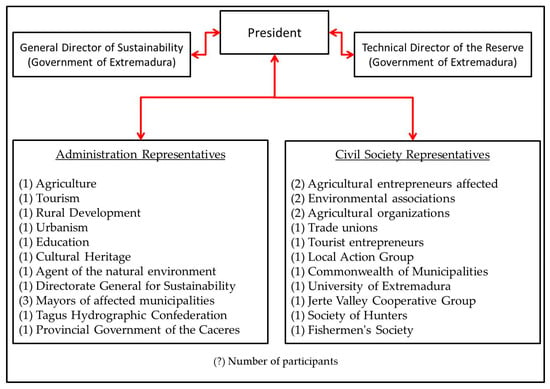
Figure 2.
Organization Chart of the Governing Board (Garganta de los Infiernos Natural Reserve). Source: Prepared by the authors (DOE 35, 20 February 2017).
The main purpose of the Governing Board is to get the partners represented in it to become involved in a socialized management of the protected area, since that involvement guarantees the highest environmental, social, economic and cultural benefits for the protected area [68,69,70,71]. One of the main objectives of the Governing Board is to “promote the sustainable use of natural resources in the space and its area of socioeconomic influence” (published in DOE 44, 5 March 2010). Recently, according to the Masterplan for the Use and Management of the Garganta de los Infiernos Natural Reserve, the Governing Board of the Reserve has decided to limit the capacity of the bathing area of “Los Pilones” to a total of 150 visitors per day by summer 2020, due to the situation caused by Covid-19 (Figure 3). The University of Extremadura is developing a research project to estimate the carrying capacity of the protected area that will end in 2021.
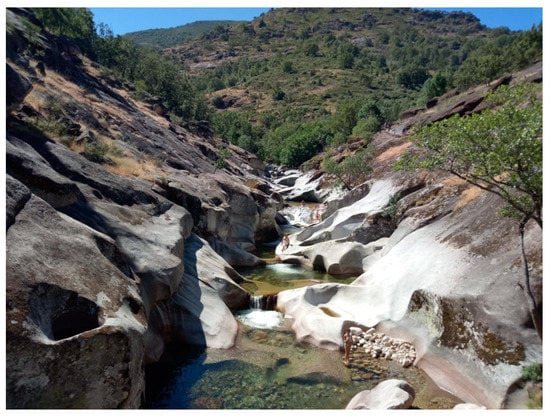
Figure 3.
Public use area “Los Pilones” (Garganta de los Infiernos Natural Reserve). Source: Prepared by the authors.
As the problem of carrying capacity is known, the solution proposed by the authors is to establish the carrying capacity thresholds in subsequent investigations, since, to date, the solutions adopted by the regional administration, through the Governing Board of the Garganta de los Infiernos, have been limited to a greater control of visits at times of greater influx of visitors.
The problem is not new. In 2017, the Jerte Valley of Tourism Association urged the regional administration to take urgent action to preserve the natural environment and ensure the quality of the visitors’ experience.
In any case, the Governing Board of the Garganta de los Infiernos Natural Reserve, as previously stated, is the management entity of the protected natural area. All the social agents of the local community participate in the Governing Board. This social participation in the Governing Board is a key and innovative tool for the sustainable management of the resources of the protected natural area [72], since it stimulates communication between the social agents involved in the management and favours the creation of common responsibilities.
The innovative management carried out by the Governing Board involves three levels of action:
First: Planning. The Governing Board makes decisions based on the human, technical, economic and environmental reality of the protected area.
Second: Organization. The Governing Board is a structure that guarantees the rational distribution of resources (human and technical) in the areas of public use of the protected natural area.
Third: Evaluation and control. The Governing Board is the entity that guarantees the fulfilment of the sustainable management of the tourist resources (Figure 4).
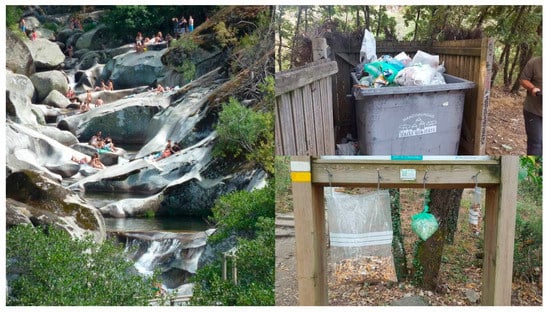
Figure 4.
Panoramic view of “Los Pilones” with an excessive number of bathers and associated impacts (Garganta de los Infiernos Natural Reserve). Source: Prepared by the authors and Libera Project.
Therefore, the Governing Board is responsible for planning, organizing and evaluating the degree of tourism sustainability in the Garganta de los Infiernos Natural Reserve. For such objectives, it is essential to have the appropriate instruments—instruments that are materialized in the quantitative (numbers of visitors, seasonality of visits) and qualitative (visitors’ perception of the quality of the tourist experience) variables.
3. Materials and Methods
In order to analyse the objectives set out in the previous section, the method used was non-experimental and applied descriptive statistical techniques. The reason for this was that the purpose of the study was not just to gather complete information about the main public use areas in the Garganta de los Infiernos Natural Reserve, but also to guarantee that those results can be used in subsequent studies.
In this piece of research, then, the following sources of information and documentation were used:
- -
- The information about the number of visitors was obtained thanks to the collaboration of the Sustainability Directorate of the Ecological Transition Department of the Extremadura Regional Government.
- -
- The information about visitors’ perception and evaluation of the area’s carrying capacity and overcrowding, together with their visiting experience in the protected area, was obtained through a social poll [73], based on the opinions of a specific group of people and using a questionnaire written beforehand (Appendix A).
The poll has been used to conduct a systematic search for information based on respondents’ personal opinions. These personal opinions were then analysed and evaluated in an aggregated manner. This is an exploratory survey, as the previous information on the object of study was scarce and unreliable.
Through the survey, the necessary information on the variables involved in visitors’ perception of the protected natural area was systematically obtained [74,75].
The survey method offers the particularity of asking the same questions to the respondents, in the same order and under the same conditions. Therefore, the differences that might be obtained basically correspond to the different perceptions of the respondents. A total of 160 opinion polls were carried out in said period. The sample can then be regarded as satisfactorily large, covering an estimated population of 9800 visitors in the period under study (Natural Reserve Interpretation Centre), offering a 95% trust level and a 7.5% error rate. This is a representative survey that guarantees the generalization of the results. The public opinion polls were carried out in person, thus avoiding the subjective parameters usually found in online polls. We decided to carry out a closed survey, as a semi-structured interview would be costly and slow to implement. The closed survey allows the same questions to be collected in a structured manner and in the same order. The questionnaire is comfortable for the interviewee, with flexible and easy to answer questions. The answers favour the codification and comparability with other answers, reducing the latter’s ambiguity.
The public opinion poll contained 14 questions (see Annex 1). The questions were related to the polled persons’ profile (origin, age and occupation), their reasons to visit, their accommodation in the area and their opinions about the carrying capacity of the most overcrowded public use areas—in this case, the area called “Los Pilones”, which is used for bathing, together with the parking lots.
The answers provided by the polled visitors were used in order to group, assess, quantify and connect the results, and to study their incidence and interrelation [76].
4. Results
4.1. Analysis and Assessment of the Amount of Registered Visitors to the Visitor and Interpretation Centres in the Natural Reserve in the Last Fifteen Years
Between December 2004 and December 2019, the total number of registered visitors to the Natural Reserve Interpretation Centre was 578,188. This amounts to 16.3% of the total number of registered visits within the protected natural areas network in all of Extremadura.
The yearly average of visitors between 2004 and 2019 was 36,137. However, the actual number of visitors is probably much higher, since many of the visitors never register at the protected area’s visitor centre. Thus, the Garganta de los Infiernos Natural Reserve takes second place among all protected natural areas in Extremadura, Monfragüe National Park and Biosphere Reserve being the only one ahead of it (Table 1).

Table 1.
Evolution of the number of visitors in the Garganta de los Infiernos Natural Reserve, 2004–2019.
4.2. Seasonality Study of the Number of Registered Visitors in the Visitor and Interpretation Centres of the Natural Reserve in the Last Fifteen Years
The average monthly distribution of visitors in the period under study shows a strong tendency for the demand to concentrate in just a few months. Specifically, an average 55.4% of all visits in the year take place in the months of March, April and May, which coincide with such important festivities as Easter, a local celebration called Cerezo en Flor (“Blooming Cherry Trees”) and the so-called Puente de Mayo (literally, “May Bridge”, an extra free day preceding or following 1 May). Another period containing a peak in visitor flow is August (11.2%) (Figure 5).
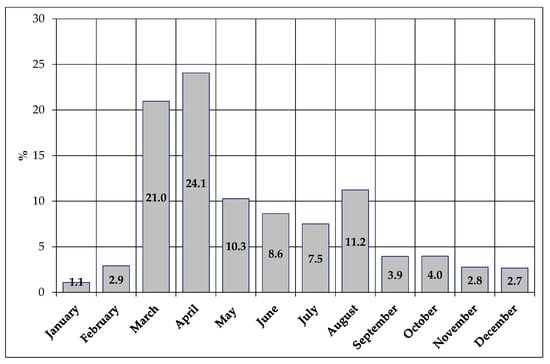
Figure 5.
Average monthly distribution of the number of visitors at the Garganta de los Infiernos Natural Reserve, 2004–2019. Source: Prepared by the authors.
The evolution of the annual and seasonal number of visitors suggests, to the authors of this research, the need to propose measures that could de-seasonalise the demand that occurs in the months of March, April, May and August, months that reach 66.6% of the average number of visits per year.
4.3. Assessment and Analysis of the Public Opinion Polls
- a.
- In the first place, it must be noted that 90.8% of the registered visitors to the Natural Reserve come from Spain, mainly from Extremadura itself (27.9%), Madrid (20.2%), Castilla and Leon (13.5%) and the País Vasco (11.5%). Just 9.6% of the polled visitors came from abroad. Therefore, there is insufficient internationalisation of visits to the protected area (Table 2; Figure 6).
 Table 2. Origin of the visitors to the Garganta de los Infiernos Natural Reserve, 2004–2019.
Table 2. Origin of the visitors to the Garganta de los Infiernos Natural Reserve, 2004–2019.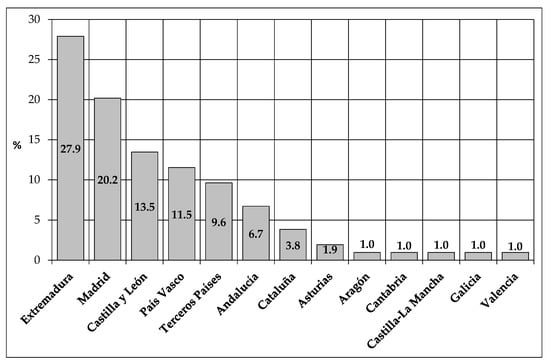 Figure 6. Origin of the visitors to the Garganta de los Infiernos Natural Reserve, 2004–2019. Source: Prepared by the authors.
Figure 6. Origin of the visitors to the Garganta de los Infiernos Natural Reserve, 2004–2019. Source: Prepared by the authors. - b.
- In the second place, the most outstanding age group among the polled persons is that of visitors between 30 and 50 years of age, which is 57.5% of the total number. Regarding the social and professional profile of the polled visitors, most of them work in the service sector, which takes almost 60% of the total number of polled persons (Table 3; Figure 7). The statistics reflect a low number of visitors under 30 years of age (26%), which suggests the importance of encouraging awareness campaigns aimed primarily at students.
 Table 3. Socio-professional profile of visitors to the Garganta de los Infiernos Natural Reserve, 2004–2019.
Table 3. Socio-professional profile of visitors to the Garganta de los Infiernos Natural Reserve, 2004–2019.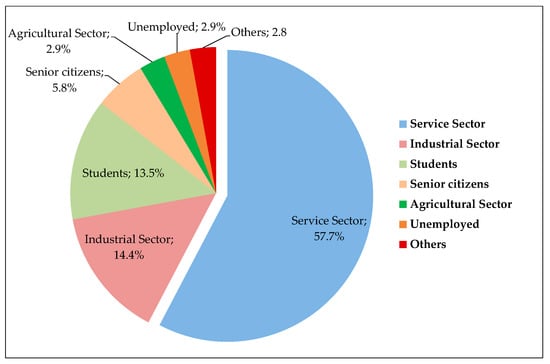 Figure 7. Socio-professional profile of visitors to the Garganta de los Infiernos Natural Reserve, 2004–2019. Source: Prepared by the authors.
Figure 7. Socio-professional profile of visitors to the Garganta de los Infiernos Natural Reserve, 2004–2019. Source: Prepared by the authors. - c.
- In the third place, another useful bit of information obtained from the public opinion poll had to do with the reasons for visiting the protected area and, at the same time, any previous trips to the place the polled persons may have participated in.
Thus, 29.8% of the polled visitors answered that their only reason to visit was to see the Garganta de los Infiernos Natural Reserve for the first time. For another 44%, the main reason for their visit included getting to know and to enjoy a larger territory: the Jerte Valley. In this case, the territorial expectations of the visitors are due to the natural and cultural values which the Jerte Valley is known for.
For almost half the polled persons (49%), this was the first time they visited the protected area. The remaining half had visited the Natural Reserve more than twice, which shows the visitors’ fidelity to this protected area.
- d.
- The poll also contained a question about the number of people accompanying each visitor. A surprising 77.9% of the polled visitors were members of groups between 2 and 5 persons, that is, reduced groups offering a greater probability for a better quality experience (Figure 8).
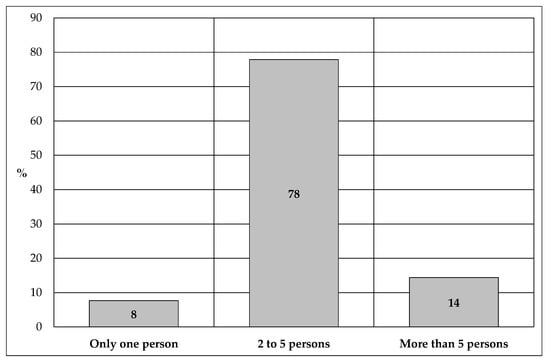 Figure 8. Number of people travelling with visitors to the Garganta de los Infiernos Natural Reserve, 2004–2019. Source: Prepared by the authors.
Figure 8. Number of people travelling with visitors to the Garganta de los Infiernos Natural Reserve, 2004–2019. Source: Prepared by the authors. - e.
- One of the essential aspects of tourism in protected natural areas is that it must be an important part of the local economy and development by involving the lodging capacity of the area (Figure 9). In this case, more than 60% of the participants in the poll answered that they were staying in the Jerte Valley at the time of the visit. This is a remarkable figure, but it can be further improved. The favourite kinds of accommodation for visitors were holiday cottages (40.6%) and camping sites (23.4%). These data relate positively to the average number of people travelling together.
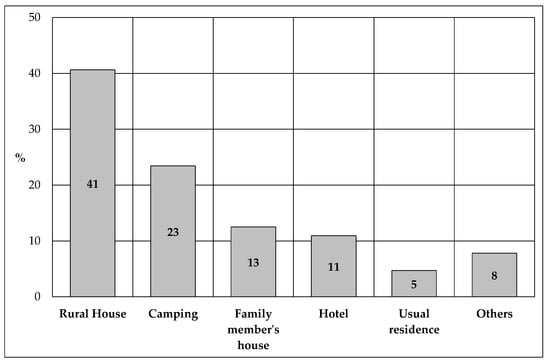 Figure 9. Type of accommodation preferred by visitors to the Garganta de los Infiernos Natural Reserve, 2004–2019, Source: Prepared by the authors.
Figure 9. Type of accommodation preferred by visitors to the Garganta de los Infiernos Natural Reserve, 2004–2019, Source: Prepared by the authors. - f.
- On the other hand, the answers given by the visitors to questions related to their perception of how overcrowded public use areas (bathing areas and parking lots) were show pretty evident contrasts. In the opinion of 47.1% of those who took the poll, the number of people they found in the bathing areas was too high, whereas 45.2% of the same group did not find it high at all. Likewise, according to 44.2% of the participants, there were too many vehicles in the parking lots, while 48.1% did not regard the number of vehicles as too high.
The answers given to the questions in the poll about access regulation to bathing areas and parking lots were quite similar. Those answers coincided in pointing out the good, positive attitude of visitors and users towards a better management of these public use areas.
Additionally, it is worth pointing out that nearly 40% of the polled visitors agreed on the necessity to regulate and manage all access points to the public use areas (Table 4).

Table 4.
Regulation of access to public use areas of the Garganta de los Infiernos Natural Reserve, 2004–2019.
- g.
- The last, very important question in the poll was related to the quality of the experience as a whole. Here, 99% of the visitors who took the poll replied that their visiting experience had been “good” or “excellent”, thus labelling the experience as a top quality one (Figure 10).
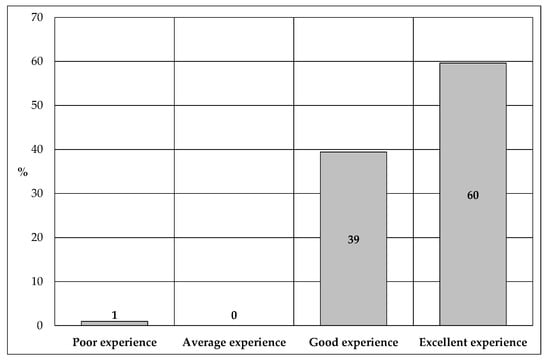 Figure 10. Quality of the visit to the protected area of the Garganta de los Infiernos Natural Reserve, 2004–2019. Source: Prepared by the authors.
Figure 10. Quality of the visit to the protected area of the Garganta de los Infiernos Natural Reserve, 2004–2019. Source: Prepared by the authors.
As pointed out in, the results about the quality of the visit provided by those who took the poll fully coincide with the results of the polls made at the Garganta de los Infiernos Natural Reserve Interpretation Centre itself (Table 5; Figure 11).

Table 5.
Quality of infrastructure and facilities of the Garganta de los Infiernos Natural Reserve, 2012–2019 (Scale 1 to 5).
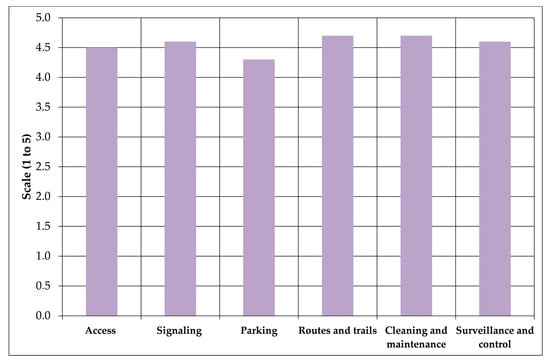
Figure 11.
Quality of infrastructure and facilities of the Garganta de los Infiernos Natural Reserve, 2012–2019 (Scale 1 to 5). Source: Prepared by the authors.
5. Discussion
Despite the apparent complexity of the tourist carrying capacity concept, there is a common definition: “carrying capacity represents the maximum number of visitors that a geographic place can welcome without it causing an unacceptable alteration in the physical and social environment”.
However, the perceptual or social carrying capacity is a complex and unquantifiable variable, taking into account that people’s cognitive strategies are different [18,77], even though the standards for evaluation set the threshold for exceeding the perceptual load capacity at 60% [78].
The results of this research show that just 47% of the visitors find the number of people in the public use areas of the protected area excessive (parking lots and bathing areas, called backcountry areas in the scientific literature).
In any case, the population sample is sensitive to the problem of overcrowding, given that 39% of respondents are in favour of regulating the access and controlling the flow of visitors in the protected area, aspects that have already been evaluated by other authors [4,79,80].
These data highlight the good attitude of visitors towards tourist activity and the sensitivity shown towards the problem of overcrowding.
On the other hand, the average number of visitors in the Natural Reserve´s Interpretation Centres over the last fifteen years has remained stable at around 40,000 people. Although the strong seasonal nature of visits in this protected natural area has been demonstrated, previous studies had already demonstrated this problem [81].
There is a clear concentration of demand in the months of March, April and May that gathered 66.6% of the average number of visits per year, leading to problems of overcrowding that, however, do not affect the quality of the recreational experience [58,82].
The traditional tourist vocation of Jerte Valley, linked to the marketing of certain events by the regional and local administration (the local celebration called “Blooming Cherry Trees” and the so-called “May Bridge”, an extra free day preceding or following 1 May), attract thousands of visitors to Jerte Valley every year exclusively in spring. In this sense, the local administration of Jerte Valley has become aware of this problem and is taking measures to de-seasonalize the demand with actions and events such as (“Autumn in Valle del Jerte”): http://soprodevaje.blogspot.com/2019/08/otonada-2019-valle-del-jerte.html.
Moreover, there is an insufficient internationalisation of visits to the protected area, given that among the sample of the population surveyed only 9.6% of visitors were international, far from the 40% of foreign visitors that Spanish national parks record on average [83].
On the other hand, although the statistics reflect a low number of visitors under the age of 30 (26%), we must be aware that the surveys were conducted during the months of May, July and August 2019, a time of year when student groups do not organize visits due to being outside the annual school term.
However, environmental education in protected natural areas is fundamental as a development strategy, as some authors point out, mostly when the strategy is aimed at young students [84,85,86].
The results obtained show that the model visitor is between 30 and 50 years old (57.5% of those surveyed), values close to those referred to in Spanish national parks [83].
Another point for discussion is the number of people visiting the protected area. In the Natural Reserve, visits in small groups predominate (78% 2 to 5 persons). The experiences in small groups are associated with areas of high ecological value (backcountry areas), and similar evaluations have been found in the scientific bibliography [36,49,53]. Furthermore, these visits are associated with positive experiences (99% of the visitors who took the poll replied that their visiting experience had been “good” or “excellent”, thus labelling the experience as a top quality one).
Finally, given that the territorial expectations of the visitors go beyond the protected area itself, to the natural and cultural values that the Jerte Valley is known for, it would be interesting for future researchers to carry out surveys focused on the inhabitants, to evaluate the perception of tourism from the perspective of the local community. It would also be advisable to carry out surveys at different periods of the year in order to increase the profiles of people and have a wider evaluation of the perception of the recreational experience in this protected natural area.
6. Conclusions
To begin with, it is worth noting that the main conclusions of this piece of research aim at becoming essentially helpful for the management of public use areas in the Garganta de los Infiernos Natural Reserve, carried out by the managing body of the protected area, to which they will be submitted.
The purpose of this is, in the first place, to provide the Junta Rectora (Governing Board) of the Natural Reserve with an instrument enabling them to properly manage the public use areas [4] while the touristic quality of the visits and activities remains unchanged.
Therefore, it would be advisable, firstly, that all protected natural areas have a management and participation agency. This management agency should be responsible for planning, organising and evaluating the degree of tourism sustainability of the protected area. Secondly, the management and participation agencies must have the appropriate instruments to do so. These instruments must take into account statistical variables (referring to the volume and seasonality of visits) and qualitative variables, referring to the visitors’ perception of the quality of the tourist experience. This participatory management is an innovative way of managing the tourism carrying capacity and guaranteeing the conservation of natural resources, and would also be a logical proposal for implementation in other protected natural areas. Secondly, considerable emphasis is placed on the periodic monitoring of the visitors’ personal perception of the state of facilities and, in general, of the public use areas within the protected area.
Thirdly, it has been proved that the Natural Reserve has received a constantly large number of visitors per year (36,000 on average) in the last 15 years, although the demand of services is mostly concentrated in spring and summer. In view of this, two actions become evidently necessary: on the one hand, suitable governance at peak times of visitor affluence; and, on the other hand, the creation of programmes (services, activities, etc.) aimed at arousing user demand during those periods with fewer visitors. In addition, it is necessary to put into practice alternative marketing options to improve the flow of foreign visitors, for they amount to just 9.6% of the total figure at present.
Fourthly, it is necessary to point out that the Natural Reserve and the Jerte Valley are inextricably interrelated. The two combined make up a large territorial continuum, possessing a consolidated touristic quality brand and offering tourism-related activities, among which the Natural Reserve stands out. Additionally, Jerte Valley offers a varied cultural, natural and environmental heritage endowed with highly diverse territorial identity marks.
Fifthly, tourists visiting the Natural Reserve usually travel in small-size groups. Eighty percent of the visitors belong to groups with 2–5 people. This aspect decisively affects the quality of the visiting experience.
Sixthly, it should be noted that touristic activity in the Garganta de los Infiernos Natural Reserve generates important financial income to the Jerte Valley district, since more than 60% of visitors end up using any of the rural accommodation options available. However, this sector in particular still needs to improve all of its offer modalities.
Seventhly, after the analysis of the poll results, it becomes clear that users themselves consider it necessary to regulate the access to those public use areas receiving most visitors. Such regulation process would demand some previous agreement and cooperation among all the main partners belonging to the Natural Reserve’s Junta Rectora (Managing Board). Thus, after learning about the issues related to the carrying capacity of these public use areas, together with massification problems, the Junta Rectora agreed on a number of measures to improve the management of these public use areas. It is only through consensus that conflicts can be overcome [87] and objectives reached for sustainable tourism development to generate financial income on a local scale and, at the same time, avoid negative environmental impact on the protected area.
Therefore, the starting hypothesis is demonstrated in the sense that an important proportion of the visitors, according to the results obtained in the opinion polls, consider that the public use areas of the Garganta de los Infiernos Natural Reserve are already encountering problems of overcrowding on certain annual dates, an aspect that will result in a loss of quality of the visit in the end.
For these reasons, at present, and as mentioned above, the University of Extremadura is carrying out a research project to evaluate the load capacity of the protected area. In this way, a new valid parameter can be obtained for establishing the real load thresholds which, together with the results of the surveys of this work, will serve to improve the quality of the visit.
Therefore, it is important to finish by pointing out that public participation and active citizenship have recently become key for the governance and management of protected natural areas [88]. The ideal paradigm of a protected area nowadays lies not just in the preservation of animal and plant species and biotopes, for there is an increasing demand for integrated management by means of governance, the involvement of all social partners being vital for policy-making.
The Junta Rectora of the Garganta de los Infiernos Natural Reserve is an ideal example of civic participation in the management of a natural area. Their concern with improving visitors’ quality of experience (60% of visitors affirm that their visiting experience was “very good”) is a clear sign of commitment to quality tourism while at the same time respecting natural resources and territorial identity.
Author Contributions
Conceptualization, A.B.M. and F.L.; methodology, A.B.M. and F.L.; validation, A.B.M. and F.L.; formal analysis, A.B.M., F.L. and A.P.; investigation A.B.M., F.L. and A.P.; resources, A.B.M. and F.L.; writing—original draft preparation, A.B.M. and F.L.; writing—review and editing, A.B.M. and F.L.; visualization, A.B.M. and F.L.; supervision, A.B.M. and F.L. All authors have read and agreed to the published version of the manuscript.
Funding
This research received no external funding.
Acknowledgments
This research was carried out at the “Heritage Research Institute” of the University of Extremadura (Cáceres, Spain).
Conflicts of Interest
The authors declare no conflict of interest.
Appendix A

Table A1.
Public Opinion Polling Model.
Table A1.
Public Opinion Polling Model.
| |
| Under 20 years |
| From 20 to 30 years | |
| From 30 to 50 years | |
| More than 50 years | |
| Student |
| Service sector | |
| Industrial sector | |
| Agricultural sector | |
| Administration | |
| Education | |
| Unemployed | |
| Others | |
| One visit |
| From 2 to 5 visits | |
| More than 5 visits | |
| Only one person |
| 2 to 5 persons | |
| More than 5 persons | |
| |
| Hotel |
| Rural house | |
| Camping | |
| Family member’s house | |
| Usual residence | |
| Others | |
| Getting to know the Natural Reserve |
| Getting to know the “Jerte Valley” | |
| Other objectives | |
| Yes |
| No | |
| DK/NA | |
| Yes |
| No | |
| DK/NA | |
| Yes |
| No | |
| DK/NA | |
| Yes |
| No | |
| DK/NA | |
| Yes |
| No | |
| DK/NA | |
| Excellent |
| Good | |
| Average | |
| Poor |
References
- Leung, Y.F.; Spenceley, A.; Hvenegaard, G.; Buckley, R. Tourism and Visitor Management in Protected Areas: Guidelines for Sustainability; IUCN: Gland, Switzerland, 2018; Volume 27, 120p. [Google Scholar]
- Marcos, D.; González, D.J. Turismo Accesible; Comité Español de Representantes de Personas con Discapacidad (CERMI): Madrid, Spain, 2003; 130p. [Google Scholar]
- EUROPARC-España. Memoria de Actividades: EUROPARC-España 2011–2012; Fundación Fernando González Bernáldez: Madrid, Spain, 2012; pp. 1–24. [Google Scholar]
- Limón, J.G.; García, D. Capacidad de Acogida de Uso Público en los Espacios Naturales Protegidos; Organismo Autónomo de Parques Nacionales: Madrid, Spain, 2014; 89p. [Google Scholar]
- Berrocal, F.L.; Rodríguez, A.B.M.; Díaz, A.P. Estudio de la demanda del turismo en el Parque Nacional y Reserva de la Biosfera de Monfragüe. Cuad. Tur. 2015, 35, 231–257. [Google Scholar] [CrossRef]
- Borrini-Feyerabend, G.; Dudley, N.; Jaeger, T.; Lassen, B.; Pathnak, N.; Philips, A.; Sandwith, T. Governance of Areas: From Understanding to Action; IUCN: Gland, Switzerland, 2013; 144p. [Google Scholar]
- Graham, J.; Amos, B.; Plumptre, T. Governance Principles for Protected Areas in the 21st Century: A Discussion Paper; Institute on Governance: Ottawa, ON, Canada, 2003; 50p. [Google Scholar]
- Romagosa, F.; Eagles, P.; Buteau-Duitschaever, W. Evaluación de la gobernanza en los espacios naturales protegidos. El caso de la Columbia Británica y Ontario (Canadá). An. Geogr. Univ. Complut. 2012, 32, 133–151. [Google Scholar] [CrossRef]
- Ballester, J.M.P.; Calderón, E.P. Análisis de la gobernanza en los parques nacionales españoles a partir de un análisis Delphi. Pap. Tur. 2017, 60, 41–64. [Google Scholar]
- World Tourism Organization. Tourism Congestion Management at Natural and Cultural Sites; UNWTO: Madrid, Spain, 2005; 147p. [Google Scholar] [CrossRef]
- Aguilera, P. Manual de Buenas Prácticas del Monitor de Naturaleza: Espacios Naturales Protegidos de Andalucía; Consejería de Medio Ambiente: Sevilla, Spain, 2000; 250p. [Google Scholar]
- Luque, A.M.; Blanco, R. La regulación de las prácticas recreativas en los Parques Naturales Andaluces. Rev. Baética 2007, 29, 73–103. [Google Scholar] [CrossRef]
- Martín, J.M.S.; Gallego, J.I.R.; Delgado, L.M.M. Tourist mobility at the destination toward protected areas: The case-study of Extremadura. Sustainability 2018, 10, 4853. [Google Scholar] [CrossRef]
- de las Heras, M.P. La Guía del Ecoturismo: O Como Conservar la Naturaleza a Través del Turismo; Mundi-Prensa: Madrid, Spain, 2012; 250p. [Google Scholar]
- Gordi, J. La planificación del uso público en los espacios naturales protegidos. In Actas del VII Coloquio de Geografía Rural; Españoles, A.d.G., Ed.; Servicio de Publicaciones de la Universidad de Córdoba: Córdoba, Spain, 1994; pp. 393–404. [Google Scholar]
- EUROPARC-España. Conceptos de Uso Público en los Espacios Naturales Protegidos; Fundación Fernando González Bernáldez: Madrid, Spain, 2005; 98p. [Google Scholar]
- O’Reilly, A.M. Tourism carrying capacity: Concepts and issues. Tour. Manag. 1986, 7, 254–258. [Google Scholar] [CrossRef]
- Shelby, B.; Heberlein, T.A. Social Carrying Capacity in Recreation Settings; Oregon State University Press: Corvallis, OR, USA, 1986. [Google Scholar]
- Sowman, M.R. A procedure for asseissing recreational carrying capacity of coastal resort areas. Landsc. Urban Plan. 1987, 14, 331–334. [Google Scholar] [CrossRef]
- Hernández, M.G.G.; Vaquero, M.C.; García, M.D.M. Capacidad de carga turística y espacios patrimoniales. Aproximación a la estimación de la capacidad de carga del conjunto arqueológico de Carmona (Sevilla, España) Boletín Asoc. Geógrafos Españoles 2011, 57, 219–241. [Google Scholar]
- Stankey, G.H.; McCool, S.F. Beyond social carrying capacity. In Understanding Leisure Research Recreation; Jackson, E.B., Ed.; Venture Publishing: State College, PA, USA, 1983; pp. 497–516. [Google Scholar]
- Wagar, J.A. The Carrying Capacity of Wildlands for Recreation; Society of American Foresters: Washington, DC, USA, 1964; 31p. [Google Scholar]
- Eagles, P.; McCool, S.; Haynes, C. Turismo Sostenible en Areas Protegidas: Directrices de Planificación y Gestión; Organización Mundial del Turismo: Madrid, Spain, 2002; 198p. [Google Scholar]
- González, A.M.; Martin, A. Governance Trends in Protected Areas: Experiences from the Parks in Peril Program in Latin America and the Caribbean; The Nature Conservancy: Arlintong, VA, USA, 2007. [Google Scholar]
- Pedersen, A. Managing Tourism at World Heritage Sites: A Practical Manual for World Heritage Site Managers; UNESCO World Heritage Centre: Paris, France, 2002; 96p. [Google Scholar]
- Lime, D.; Stankey, G. Carrying Capacity: Maintaining Outdoor Recreation Quality. In Proceedings of the Forest Recreation Symposium, New York, NY, USA, 12–14 October 1971; Larson, E.v.H., Ed.; State University of New York College of Forestry: New York, NY, USA, 1971; pp. 174–184. [Google Scholar]
- Watson, G.L.; Kopachevsky, J.P. Tourist carrying capacity: A critical look at the discursive dimension. Prog. Tour. Hosp. Res. 1996, 2, 169–179. [Google Scholar] [CrossRef]
- MacColl, S.; Lime, D. Tourism carrying capacity: Tempting fantast or useful reality. J. Sustain. Tour. 2001, 9, 372–388. [Google Scholar] [CrossRef]
- Laboratory of Environmental Planning; Department of Environmental Stutides. Defining, Measuring and Evaluating Carrying Capacity in European Tourism Destinations: Material for a Document; B4-3040/2000/294577/MAR/D2; University of The Aegean: Athens, Greece, 2001. [Google Scholar]
- Lorente, P.E. La capacidad de carga turística. Aspectos conceptuales y normas de aplicación. An. Geogr. Univ. Complut. 2001, 21, 11–30. [Google Scholar] [CrossRef]
- Jurado, E.N. Indicadores para la evaluación de la capacidad de carga turística. Ann. Tour. Res. 2005, 7, 397–422. [Google Scholar]
- Kostopoulou, S.; Kyritsis, I. A tourism carrying capacity indicator for protected areas, Anatolia. Int. J. Tour. Hosp. Res. 2007, 17, 5–24. [Google Scholar]
- Greist, D.A. The carrying capacity of public wild land recreation areas: Evaluation of alternative measures. J. Leis. Res. 1976, 8, 123–128. [Google Scholar] [CrossRef]
- Butler, R.W. The tourism area life cycle in the twenty-first century. In A Companion to Tourism; Lew, A.E.A., Ed.; Blackwell Publishing: Oxford, UK, 2004. [Google Scholar]
- Butler, R.W.; Waldbrook, L.A. A new planning tool: The tourism opportunity spectrum. J. Tour. Stud. 1991, 2, 2–14. [Google Scholar]
- López, J.P. Desarrollo y aplicación de un modelo de análisis de capacidad de acogida perceptual en espacios naturales protegidos. Rev. Análisis Turístico 2007, 3, 75–92. [Google Scholar] [CrossRef]
- Alipour, H.; Altinay, M.; Hussain, K.; Sheikhani, N. Perceptions of the beach users: A case study of the coastal areas of North Cyprus towards establishment of a carrying capacity. FIU Rev. 2007, 24, 28–48. [Google Scholar] [CrossRef][Green Version]
- Jin, Q.; Pearce, P. Tourist perception of crowding and management approaches at tourist sites in Xi´an. Asia Pac. J. Tour. Res. 2011, 16, 325–338. [Google Scholar] [CrossRef]
- Neuts, B.; Nijkamp, P.; Van Leerwen, E. Crowding externalities from tourist uses of urban space. Tour. Econ. 2012, 18, 649–670. [Google Scholar] [CrossRef]
- Márquez, L.A.M.; Colmenares, S.P. Revisión sobre capacidad de carga turística y la prevención de problemas ambientales en destinos emergentes. Anu. Tur. Soc. 2019, 24, 77–100. [Google Scholar] [CrossRef]
- Gregory, R.B.; Soberanis, F.E.; Mejía, J.A.M. La capacidad de carga psicosocial del turista: Instrumento de medición para el desarrollo sostenible en la turistificación de los Cenotes. Cuad. Tur. 2019, 43, 169–186. [Google Scholar] [CrossRef]
- Cortés, E.C.; López, J.P. Desarrollo de un modelo de análisis de la capacidad de acogida perceptual y aplicación práctica del mismo. Rev. Análisis Turístico 2007, 3, 75–92. [Google Scholar]
- Marzetti, S.; Brandolini, D.; Mosetti, R. Sustainable tourism development and social carrying capacity: A case study on the North-Western Adriatic Sea. In Sustainable Tourism; Pineda, F.D., Brebbia, C.A.M., Eds.; WIT Press: Southampton, UK, 2004. [Google Scholar]
- I Munar, F.X.R. Análisis de la relación entre capacidad de carga física y capacidad de carga perceptual en playas naturales de la isla de Menorca. Investig. Geográficas 2003, 31, 107–118. [Google Scholar] [CrossRef]
- Saveriades, A. The social carrying capacity for the tourist resorts of the East Coast of the Republic of Cyprus. J. Sustain. Tour. 2000, 21, 147–156. [Google Scholar]
- Soriano, K.A.; Pavón, R.G.S.; Arcos, L.A.; Barquín, R.C.S. A dimensão social na capacidade de carga turística: Estudo de caso da praia Chen Río, Ilha de Cozumel, México. Terr@ Plur. 2013, 7, 157–170. [Google Scholar] [CrossRef]
- Capocchi, A.; Vallone, C.; Pierotti, M.; Amaduzzi, A. Overtourism: A literature review to assess implications and future perspectives. Sustainability 2019, 11, 3303. [Google Scholar] [CrossRef]
- Clivaz, C.; Hausser, Y.; Michelet, J. Tourism Monitoring System Based on the Concept of Carrying Capacity—The Case of the Regional Natural Park Pfyn-Finges (Switxerland); Finnish Forest Research Institute: Vantaa, Finland, 2004; Volume 2, pp. 230–235. [Google Scholar]
- Baum, A.; Paulus, P.B. Crowding. In Handbook of Environmental Psychology; Stokols, D., Altman, I., Eds.; Wiley: New York, NY, USA, 1987; Volume 1, pp. 533–570. [Google Scholar]
- Gramann, J.H. Toward behavioral theory of crowding in outdoor recreation: An evaluation and synthesis of research. Leis. Sci. 1982, 5, 109–126. [Google Scholar] [CrossRef]
- Stokols, P. On the distinction between density and crowding: Some implications for future research. Psychol. Rev. 1972, 79, 275–277. [Google Scholar] [CrossRef]
- Cifuentes, M. Determinación de la Capacidad de la Carga Turística en Areas Protegidas; Centro Agronomico de Investigacion y Ensenanza (CATIE): Turrialba, Costa Rica, 1992; 28p. [Google Scholar]
- Manning, R.; Lime, D.W.; Freimund, W.A.; Pitt, D.G. Crowding norms at frontcountry sites: A visual standard approach to setting standars of quality. Leis. Sci. 1996, 18, 39–59. [Google Scholar] [CrossRef]
- Prato, T. Modeling carrying capacity for National Parks. Ecol. Econ. 2001, 39, 321–331. [Google Scholar] [CrossRef]
- Serrano, M.L.T.; Alarte, A.I.G. Determinación de la capacidad de carga turística en tres senderos de pequeño recorrido en el municipio de Cehegín (Murcia). Cuad. Tur. 2008, 22, 211–230. [Google Scholar]
- Navarro Jurado, E.; Tejada Tejada, M.; Almeida García, F.; Cabello González, J.; Cortés Macías, R.; Delgado Peña, J.; Fernández Gutiérrez, F.; Gutiérrez Fernández, G.; Luque Gallego, M.; Málvarez García, G.; et al. Carrying capacity assesment for tourist destinations. Methodology for the creation of synthetic indicators in a costal area. Tour. Manag. 2012, 33, 1337–1346. [Google Scholar] [CrossRef]
- Schwartz, Z.; Stewart, W.; Backlund, E.A. Visitation capacity-constraint tourism destinations: Exploring revenue management at a national park. Tour. Manag. 2012, 33, 500–508. [Google Scholar] [CrossRef]
- Berrocal, F.L.; Díaz, A.P.; Rodríguez, A.B.M. Uso público y capacidad de carga perceptual en espacios naturales protegidos. Pap. Geogr. 2013, 57–58, 127–143. [Google Scholar]
- Pavón, R.S.; del Carmen, R.S.B.; del Carmen, M.M.G.; Jimenez, G.C.; Perez, J.I.J. Estrategias de control de impactos turísticos en las áreas naturales protegidas y zonas arqueológicas de Quintana Roo, México. CULTUR: Rev. Cult. Tur. 2013, 7, 6–30. [Google Scholar]
- Solís, V.V.; Aponte, A.G.P.; Palacios, L.M.L. Capacidad de carga turística en el volcán Joya Honda, San Luis Potosí, México: Una perspectiva física y perceptiva. Rev. Análisis Turístico 2013, 16, 71–80. [Google Scholar] [CrossRef]
- Díaz, H.F.S.; Solano, B.S. Determinación de la capacidad de carga turística en los sitios de visita de la Reserva Nacional Allpahuayo-Mishana, Loreto, Perú. Cienc. Amaz. (Iquitos) 2015, 5, 25–34. [Google Scholar] [CrossRef]
- Pavón, R.S. Capacidad de carga turística y aprovechamiento sustentable de áreas naturales protegidas. CIENCIA ergo-sum 2017, 24, 164–172. [Google Scholar] [CrossRef]
- Burton, R.C.J.; Phil, M.; Muir, K. La Cabida del Campo para el Recreo: Metodología y Resultados de los Estudios Ecológicos y Psicológicos en Cannock Chase, Staffordshire; Icona Monografías: Madrid, Spain, 1975; 208p. [Google Scholar]
- Manning, R. Impacts of recreation on riparian soil and vegetation. JAWRA J. Am. Water Resour. Assoc. 1979, 15, 30–43. [Google Scholar] [CrossRef]
- Folgado-Fernández, J.A.; Di-Clemente, E.; Hernández-Mogollón, J.M.; Campón-Cerro, A.M. Water tourism: A new strategy for the sustainable management of water-based ecosystems and landscapes in Extremadura (Spain). Land 2019, 8, 2. [Google Scholar] [CrossRef]
- Gallego, J.R.; Martín, J.M.S. La repercusión turística de la declaración de Monfragüe como Parque Nacional. Cuad. Geográficos 2019, 58, 121–140. [Google Scholar] [CrossRef]
- Mooser, A.; Anfuso, G.; Mestanza, C.; Williams, A.T. Management implications for the most attractive scenic sites along the Andalusia coast (SW Spain). Sustainability 2018, 10, 1328. [Google Scholar] [CrossRef]
- Borrini-Feyerabend, G. Governance of protected areas: Innovations in the air. Policy Matters 2003, 12, 92–101. [Google Scholar]
- Borrini-Feyerabend, G.; Johnston, J.; Pansky, D. Governance of protected areas. In Managing Protected Areas: A Global Guide; Lockwood, M., Worboys, G.L., Kothari, A., Eds.; Earthscan: London, UK, 2006; pp. 117–145. [Google Scholar]
- Dudley, N. Directrices para la Aplicación de las Categorías de Gestión de Areas Protegidas; IUCN: Gland, Switzerland, 2008; 96p. [Google Scholar]
- Saviano, M.; Di Nauta, P.; Montella, M.M.; Sciarelli, F. The cultural value of protected areas as models of sustainable development. Sustainability 2018, 10, 1567. [Google Scholar] [CrossRef]
- Orgaz, F.; Moral, S.; López-Guzmán, R.; Cañero, P. Estudio de la demanda existente en torno al oleoturismo: El caso de Andalucía. Cuad. Tur. 2017, 39, 437–453. [Google Scholar] [CrossRef]
- D’Ancona, M.A.C. Metodología Cuantitativa: Estrategias y Técnicas de Investigación Social; Síntesis Sociologia: Madrid, Spain, 1996; 384p. [Google Scholar]
- Bravo, R.S. Técnicas de Investigación Social: Teoría y Ejercicios; Trillas: Mexico, Mexico, 1988. [Google Scholar]
- Visauta, B. Técnicas de Investigación Social: Recogida de Datos; PPU: Barcelona, Spain, 1989. [Google Scholar]
- Sabino, C. El Proceso de Investigación; Panapo: Caracas, Venezuela, 1992. [Google Scholar]
- Chambers, T.W.C.; Price, C. Recreational congestion: Some hypotheses tested in the forest of dean. J. Rural Stud. 1986, 2, 41–52. [Google Scholar] [CrossRef]
- Kyle, G.; Graefe, A.; Manning, R. Testing of dimensionality of place attachment in recreational settings. Environ. Behav. 2005, 37, 153–177. [Google Scholar] [CrossRef]
- del Pino, S.J.L.; Calderón, S.M.; de las Huertas, M.L.; Romeero, F.A. Uso Público en Espacios Naturales; Sinless: Madrid, Spain, 2015. [Google Scholar]
- Morán, S.H. La afluencia de visitantes a los parques naturales de Castilla y León: Una cuestión problemática. Nimbus 2011, 27–28, 25–40. [Google Scholar]
- Fuentes, M.C. Análisis de la demanda de uso público en tres parques naturales de Galicia. Boletín Asoc. Geógrafos Españoles 2013, 61, 261–284. [Google Scholar] [CrossRef]
- López, J.P. Demanda de Espacios Naturales para el Ocio: Modelos de Capacidad de Acogida Perceptual: Aplicación a los Parques Nacionales de Timanfaya y Ordesa y Monte Perdido. Ph.D. Thesis, Universidad Politecnica de Madrid, Madrid, Spain, 2005. [Google Scholar]
- Quesada, F.B.C.; Sánchez, M.S.A. Los parques nacionales españoles, catalizadores del turismo sostenible. Anu. Jurídico Económico Escur. 2014, 27, 511–534. [Google Scholar]
- Merino, C.; Jiménez, M.P.; Pitlik, P.C. Espacios naturales protegidos y educación ambiental. In La Educación Ambiental en la Sociedad Global; Minguet, P.A., Ed.; Universitat de Valencia: Valencia, Spain, 1998; pp. 292–298. [Google Scholar]
- Pazos, A.S. Los equipamientos de educación ambiental en Galicia: Un recurso para la divulgación del patrimonio natural. Ecosistemas 2004, 13, 108–113. [Google Scholar]
- Carrero, J.; Moncada, J.A.; Aranguren, J. Los parques nacionales como espacios educativos: Un estudio con docentes de educación primaria. Rev. Investig. 2011, 73, 149–168. [Google Scholar]
- Karlsen, J. Regional complexity and the need for engaged governance. Ekonomiaz 2010, 74, 91–111. [Google Scholar]
- Muñoz, J.M.B.; Ruiz, J.A.C. Participación ciudadana en la gobernanza de los espacios naturales protegidos de Andalucía: El caso del Parque Natural Bahía de Cádiz. Geographicalia 2015, 67, 1–27. [Google Scholar] [CrossRef]
Publisher’s Note: MDPI stays neutral with regard to jurisdictional claims in published maps and institutional affiliations. |
© 2020 by the authors. Licensee MDPI, Basel, Switzerland. This article is an open access article distributed under the terms and conditions of the Creative Commons Attribution (CC BY) license (http://creativecommons.org/licenses/by/4.0/).